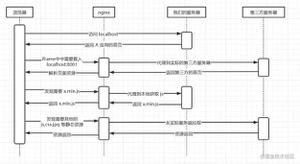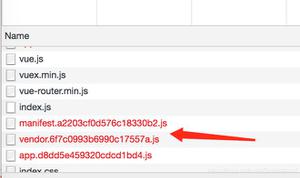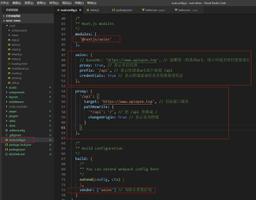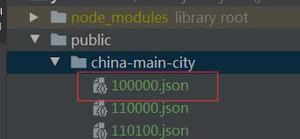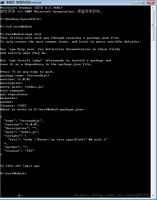「 giao-js 」用js写一个js解释器
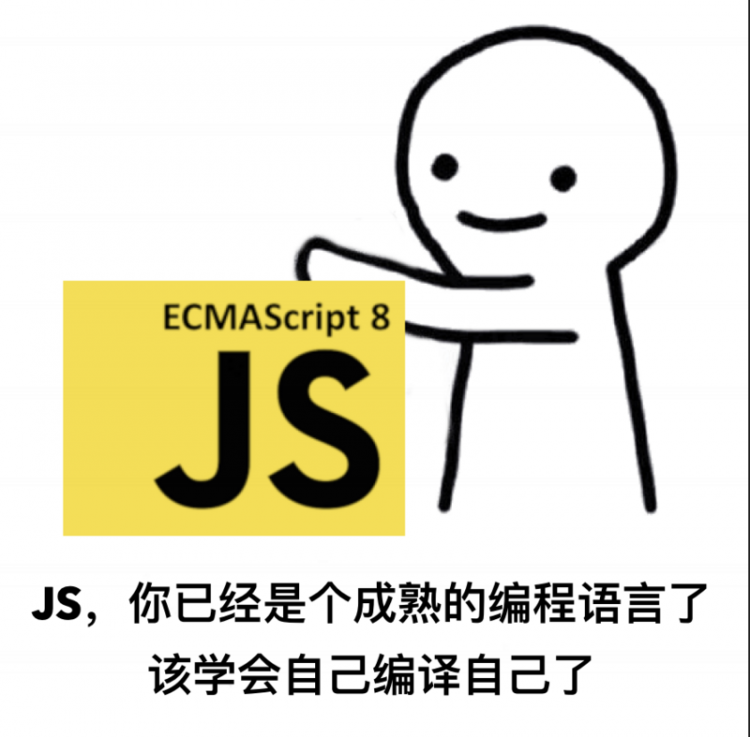
前言
什么是解释器 (Interpreter) ?
解释器 (Interpreter) 工作原理

- 词法分析 (Tokenization)
- 语法解析 (Parsing)
- 求值 (Evaluating)
词法分析 (Tokenization)
在英语中,当我们遇到这样一个语句时:
Javascript is the best language in the world我们会下意识地把句子分解成一个个单词:
+----------------------------------------------------------+| Javascript | is | the | best | language | in |the |world |
+----------------------------------------------------------+
这是分析和理解句子的第一阶段。
词法分析是由词法分析器完成的,词法分析器会扫描(scanning)代码,提取词法单元。
var a = 1;[
("var": "keyword"),
("a": "identifier"),
("=": "assignment"),
("1": "literal"),
(";": "separator"),
];
词法分析器将代码分解成 Token 后,会将 Token 传递给解析器进行解析,我们来看下解析阶段是如何工作的。
语法解析 (Parsing)
在英语中,Javascript is the best language 被分解为以下单词:
+------------------------------------------+| Javascript | is | the | best | language |
+------------------------------------------+
这样我们就可以挑选单词并形成语法结构:
"Javascript": Subject"is the best language": Predicate
"language": Object
Javascript 在语法中是一个主语名词,其余的是一个没有什么意义的句子叫做谓语,language 是动作的接受者,也就是宾语。结构是这样的:
Subject(Noun) -> Predicate -> Object语法解析是由语法解析器完成的,它会将上一步生成的 Token,根据语法规则,转为抽象语法树(AST)。
{type: "Program",
body: [
{
type: "VariableDeclaration",
declarations: [
{
type: "VariableDeclarator",
id: {
type: "Identifier",
name: "sum"
},
init: {
type: "Literal",
value: 30,
raw: "30"
}
}
],
kind: "var"
}
],
}
求值阶段 (Evaluating)
1 + 2|
|
v
+---+ +---+
| 1 | | 2 |
+---+ +---+
\ /
\ /
\ /
+---+
| + |
+---+
{
lhs: 1,
op: '+'.
rhs: 2
}
解释器解析 Ast,得到 LHS 节点,接着收集到操作符(operator)节点+,+操作符表示需要进行一次加法操作,它必须有第二个节点来进行加法操作.接着他收集到 RHS 节点。它收集到了有价值的信息并执行加法得到了结果,3。
{type: "Program",
body: [
{
type: "ExpressionStatement",
expression: {
type: "BinaryExpression",
left: {
type: "Literal",
value: 1,
raw: "1"
},
operator: "+",
right: {
type: "Literal",
value: 2,
raw: "2"
}
}
}
],
}
实践
前面我们已经介绍了解释器的工作原理,接下来我们来动动手松松筋骨吧,实现一个 Mini Js Interpreter~
实践准备
- Acorn.js
本次实践我们将使用 acorn.js ,它会帮我们进行词法分析,语法解析并转换为抽象语法树。
Webpack/Rollup/Babel(@babel/parser) 等第三方库也是使用 acorn.js 作为自己 Parser 的基础库。(站在巨人的肩膀上啊!)
- The Estree Spec
最开始 Mozilla JS Parser API 是 Mozilla 工程师在 Firefox 中创建的 SpiderMonkey 引擎输出 JavaScript AST 的规范文档,文档所描述的格式被用作操作 JAvaScript 源代码的通用语言。
随着 JavaScript 的发展,更多新的语法被加入,为了帮助发展这种格式以跟上 JavaScript 语言的发展。The ESTree Spec 就诞生了,作为参与构建和使用这些工具的人员的社区标准。
acorn.js parse 返回值符合 ESTree spec 描述的 AST 对象,这里我们使用@types/estree 做类型定义。
- Jest
号称令人愉快的 JavaScript 测试...我们使用它来进行单元测试.
- Rollup
Rollup 是一个 JavaScript 模块打包器,我们使用它来打包,以 UMD 规范对外暴露模块。
项目初始化
// visitor.ts 创建一个Visitor类,并提供一个方法操作ES节点。import * as ESTree from "estree";
class Visitor {
visitNode(node: ESTree.Node) {
// ...
}
}
export default Visitor;
// interpreter.ts 创建一个Interpreter类,用于运行ES节点树。// 创建一个Visitor实例,并使用该实例来运行ESTree节点
import Visitor from "./visitor";
import * as ESTree from "estree";
class Interpreter {
private visitor: Visitor;
constructor(visitor: Visitor) {
this.visitor = visitor;
}
interpret(node: ESTree.Node) {
this.visitor.visitNode(node);
}
}
export default Interpreter;
// vm.ts 对外暴露run方法,并使用acorn code->ast后,交给Interpreter实例进行解释。const acorn = require("acorn");
import Visitor from "./visitor";
import Interpreter from "./interpreter";
const jsInterpreter = new Interpreter(new Visitor());
export function run(code: string) {
const root = acorn.parse(code, {
ecmaVersion: 8,
sourceType: "script",
});
return jsInterpreter.interpret(root);
}
实践第 1 弹: 1+1= ?
我们这节来实现 1+1 加法的解释。首先我们通过AST explorer,看看 1+1 这段代码转换后的 AST 结构。
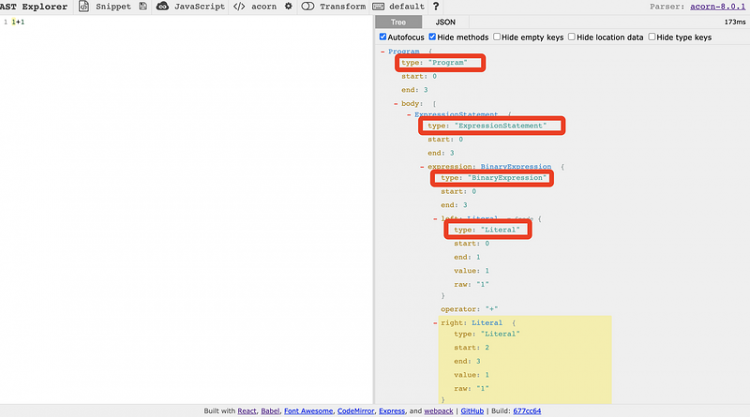
我们可以看到这段代码中存在 4 种节点类型,下面我们简单的介绍一下它们:
Program
根节点,即代表一整颗抽象语法树,body 属性是一个数组,包含了多个 Statement 节点。
interface Program {type: "Program";
sourceType: "script" | "module";
body: Array<Directive | Statement | ModuleDeclaration>;
comments?: Array<Comment>;
}
ExpressionStatement
表达式语句节点,expression 属性指向一个表达式节点对象
interface ExpressionStatement {type: "ExpressionStatement";
expression: Expression;
}
BinaryExpression
二元运算表达式节点,left 和 right 表示运算符左右的两个表达式,operator 表示一个二元运算符。
本节实现的重点,简单理解,我们只要拿到 operator 操作符的类型并实现,然后对 left,right 值进行求值即可。
interface BinaryExpression {type: "BinaryExpression";
operator: BinaryOperator;
left: Expression;
right: Expression;
}
Literal
字面量,这里不是指 [] 或者 {} 这些,而是本身语义就代表了一个值的字面量,如 1,“hello”, true 这些,还有正则表达式,如 /\d?/。
type Literal = SimpleLiteral | RegExpLiteral;interface SimpleLiteral {
type: "Literal";
value: string | boolean | number | null;
raw?: string;
}
interface RegExpLiteral {
type: "Literal";
value?: RegExp | null;
regex: {
pattern: string;
flags: string;
};
raw?: string;
}
废话少说,开撸!!!
// standard/es5.ts 实现以上节点方法import Scope from "../scope";
import * as ESTree from "estree";
import { AstPath } from "../types/index";
const es5 = {
// 根节点的处理很简单,我们只要对它的body属性进行遍历,然后访问该节点即可。
Program(node: ESTree.Program) {
node.body.forEach((bodyNode) => this.visitNode(bodyNode));
},
// 表达式语句节点的处理,同样访问expression 属性即可。
ExpressionStatement(node: ESTree.ExpressionStatement>) {
return this.visitNode(node.expression);
},
// 字面量节点处理直接求值,这里对正则表达式类型进行了特殊处理,其他类型直接返回value值即可。
Literal(node: ESTree.Literal>) {
if ((<ESTree.RegExpLiteral>node).regex) {
const { pattern, flags } = (<ESTree.RegExpLiteral>node).regex;
return new RegExp(pattern, flags);
} else return node.value;
},
// 二元运算表达式节点处理
// 对left/node两个节点(Literal)进行求值,然后实现operator类型运算,返回结果。
BinaryExpression(node: ESTree.BinaryExpression>) {
const leftNode = this.visitNode(node.left);
const operator = node.operator;
const rightNode = this.visitNode(node.right);
return {
"+": (l, r) => l + r,
"-": (l, r) => l - r,
"*": (l, r) => l * r,
"/": (l, r) => l / r,
"%": (l, r) => l % r,
"<": (l, r) => l < r,
">": (l, r) => l > r,
"<=": (l, r) => l <= r,
">=": (l, r) => l >= r,
"==": (l, r) => l == r,
"===": (l, r) => l === r,
"!=": (l, r) => l != r,
"!==": (l, r) => l !== r,
}[operator](leftNode, rightNode);
},
};
export default es5;
// visitor.tsimport Scope from "./scope";
import * as ESTree from "estree";
import es5 from "./standard/es5";
const VISITOR = {
...es5,
};
class Visitor {
// 实现访问节点方法,通过节点类型访问对应的节点方法
visitNode(node: ESTree.Node) {
return {
visitNode: this.visitNode,
...VISITOR,
}[node.type](node);
}
}
export default Visitor;
就这样,普通的二元运算就搞定啦!!!
实践第 2 弹: 怎么找到变量?
Javascript 的作用域与作用域链的概念想必大家都很熟悉了,这里就不再啰嗦了~
是的,我们需要通过实现作用域来访问变量,实现作用域链来搜寻标识符。
在这之前,我们先实现 Variable 类,实现变量的存取方法。
// variable.tsexport enum Kind {
var = "var",
let = "let",
const = "const",
}
export type KindType = "var" | "let" | "const";
export class Variable {
private _value: any;
constructor(public kind: Kind, val: any) {
this._value = val;
}
get value() {
return this._value;
}
set value(val: any) {
this._value = val;
}
}
import { Variable, Kind, KindType } from "./variable";class Scope {
// 父作用域
private parent: Scope | null;
// 当前作用域
private targetScope: { [key: string]: any };
constructor(public readonly type, parent?: Scope) {
this.parent = parent || null;
this.targetScope = new Map();
}
// 是否已定义
private hasDefinition(rawName: string): boolean {
return Boolean(this.search(rawName));
}
// var类型变量定义
public defineVar(rawName: string, value: any) {
let scope: Scope = this;
// 如果不是全局作用域且不是函数作用域,找到全局作用域,存储变量
// 这里就是我们常说的Hoisting (变量提升)
while (scope.parent && scope.type !== "function") {
scope = scope.parent;
}
// 存储变量
scope.targetScope.set(rawName, new Variable(Kind.var, value));
}
// let类型变量定义
public defineLet(rawName: string, value: any) {
this.targetScope.set(rawName, new Variable(Kind.let, value));
}
// const类型变量定义
public defineConst(rawName: string, value: any) {
this.targetScope.set(rawName, new Variable(Kind.const, value));
}
// 作用域链实现,向上查找标识符
public search(rawName: string): Variable | null {
if (this.targetScope.get(rawName)) {
return this.targetScope.get(rawName);
} else if (this.parent) {
return this.parent.search(rawName);
} else {
return null;
}
}
// 变量声明方法,变量已定义则抛出语法错误异常
public declare(kind: Kind | KindType, rawName: string, value: any) {
if (this.hasDefinition(rawName)) {
console.error(
`Uncaught SyntaxError: Identifier '${rawName}' has already been declared`
);
return true;
}
return {
[Kind.var]: () => this.defineVar(rawName, value),
[Kind.let]: () => this.defineLet(rawName, value),
[Kind.const]: () => this.defineConst(rawName, value),
}[kind]();
}
}
export default Scope;
以上就是变量对象,作用域及作用域链的基础实现了,接下来我们就可以定义及访问变量了。
实践第 3 弹: var age = 18
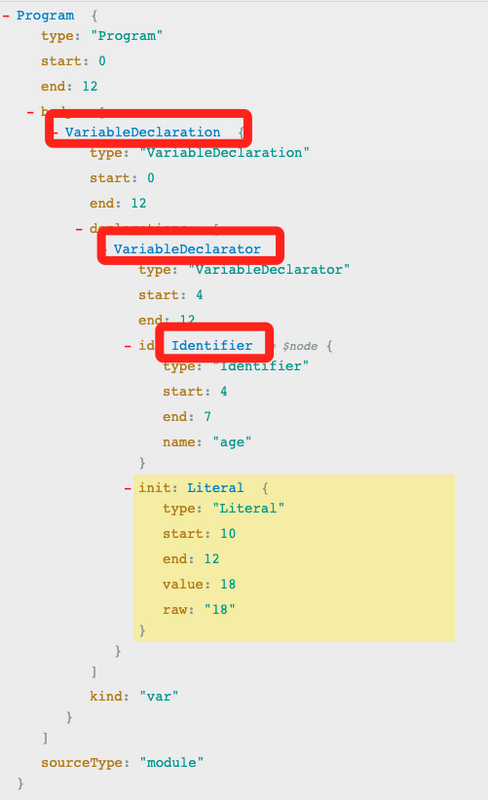
从语法树中我们可以看到三个陌生的节点类型,来看看它们分别代表什么意思:
VariableDeclaration
变量声明,kind 属性表示是什么类型的声明,因为 ES6 引入了 const/let。
declarations 表示声明的多个描述,因为我们可以这样:let a = 1, b = 2;。
interface VariableDeclaration {type: "VariableDeclaration";
declarations: Array<VariableDeclarator>;
kind: "var" | "let" | "const";
}
VariableDeclarator
变量声明的描述,id 表示变量名称节点,init 表示初始值的表达式,可以为 null。
interface VariableDeclarator {type: "VariableDeclarator";
id: Pattern;
init?: Expression | null;
}
Identifier
顾名思义,标识符节点,我们写 JS 时定义的变量名,函数名,属性名,都归为标识符。
interface Identifier {type: "Identifier";
name: string;
}
了解了对应节点的含义后,我们来进行实现:
// standard/es5.ts 实现以上节点方法import Scope from "../scope";
import * as ESTree from "estree";
type AstPath<T> = {
node: T;
scope: Scope;
};
const es5 = {
// ...
// 这里我们定义了astPath,新增了scope作用域参数
VariableDeclaration(astPath: AstPath<ESTree.VariableDeclaration>) {
const { node, scope } = astPath;
const { declarations, kind } = node;
// 上面提到,生声明可能存在多个描述(let a = 1, b = 2;),所以我们这里对它进行遍历:
// 这里遍历出来的每个item是VariableDeclarator节点
declarations.forEach((declar) => {
const { id, init } = <ESTree.VariableDeclarator>declar;
// 变量名称节点,这里拿到的是age
const key = (<ESTree.Identifier>id).name;
// 判断变量是否进行了初始化 ? 查找init节点值(Literal类型直接返回值:18) : 置为undefined;
const value = init ? this.visitNode(init, scope) : undefined;
// 根据不同的kind(var/const/let)声明进行定义,即var age = 18
scope.declare(kind, key, value);
});
},
// 标识符节点,我们只要通过访问作用域,访问该值即可。
Identifier(astPath: AstPath<ESTree.Identifier>) {
const { node, scope } = astPath;
const name = node.name;
// walk identifier
// 这个例子中查找的是age变量
const variable = scope.search(name);
// 返回的是定义的变量对象(age)的值,即18
if (variable) return variable.value;
},
};
export default es5;
实践第 4 弹: module.exports = 6
我们先来看看 module.exports = 6 对应的 AST。
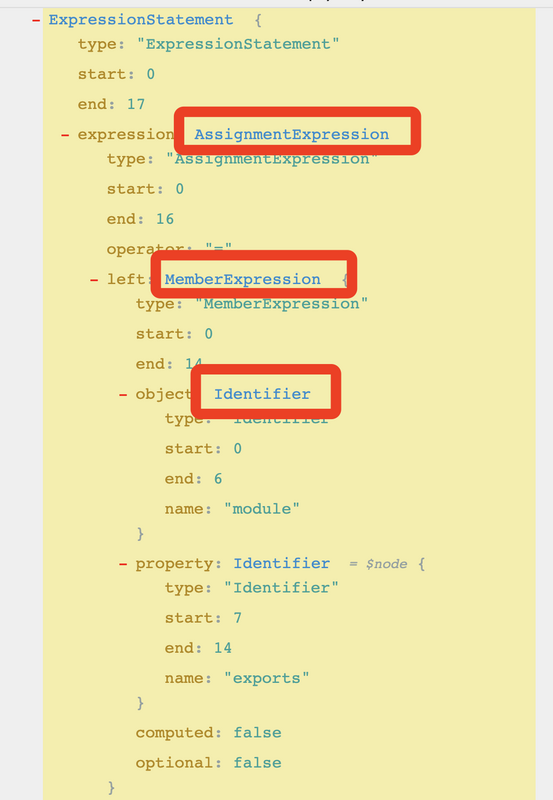
从语法树中我们又看到两个陌生的节点类型,来看看它们分别代表什么意思:
AssignmentExpression
赋值表达式节点,operator 属性表示一个赋值运算符,left 和 right 是赋值运算符左右的表达式。
interface AssignmentExpression {type: "AssignmentExpression";
operator: AssignmentOperator;
left: Pattern | MemberExpression;
right: Expression;
}
MemberExpression
成员表达式节点,即表示引用对象成员的语句,object 是引用对象的表达式节点,property 是表示属性名称,computed 如果为 false,是表示 . 来引用成员,property 应该为一个 Identifier 节点,如果 computed 属性为 true,则是 [] 来进行引用,即 property 是一个 Expression 节点,名称是表达式的结果值。
interface MemberExpression {type: "MemberExpression";
object: Expression | Super;
property: Expression;
computed: boolean;
optional: boolean;
}
我们先来定义 module.exports 变量。
import Scope from "./scope";import Visitor from "./visitor";
import * as ESTree from "estree";
class Interpreter {
private scope: Scope;
private visitor: Visitor;
constructor(visitor: Visitor) {
this.visitor = visitor;
}
interpret(node: ESTree.Node) {
this.createScope();
this.visitor.visitNode(node, this.scope);
return this.exportResult();
}
createScope() {
// 创建全局作用域
this.scope = new Scope("root");
// 定义module.exports
const $exports = {};
const $module = { exports: $exports };
this.scope.defineConst("module", $module);
this.scope.defineVar("exports", $exports);
}
// 模拟commonjs,对外暴露结果
exportResult() {
// 查找module变量
const moduleExport = this.scope.search("module");
// 返回module.exports值
return moduleExport ? moduleExport.value.exports : null;
}
}
export default Interpreter;
ok,下面我们来实现以上节点函数~
// standard/es5.ts 实现以上节点方法import Scope from "../scope";
import * as ESTree from "estree";
type AstPath<T> = {
node: T;
scope: Scope;
};
const es5 = {
// ...
// 这里我们定义了astPath,新增了scope作用域参数
MemberExpression(astPath: AstPath<ESTree.MemberExpression>) {
const { node, scope } = astPath;
const { object, property, computed } = node;
// property 是表示属性名称,computed 如果为 false,property 应该为一个 Identifier 节点,如果 computed 属性为 true,即 property 是一个 Expression 节点
// 这里我们拿到的是exports这个key值,即属性名称
const prop = computed
? this.visitNode(property, scope)
: (<ESTree.Identifier>property).name;
// object 表示对象,这里为module,对module进行节点访问
const obj = this.visitNode(object, scope);
// 访问module.exports值
return obj[prop];
},
// 赋值表达式节点
(astPath: AstPath<ESTree.>) {
const { node, scope } = astPath;
const { left, operator, right } = node;
let assignVar;
// LHS 处理
if (left.type === "Identifier") {
// 标识符类型 直接查找
const value = scope.search(left.name);
assignVar = value;
} else if (left.type === "MemberExpression") {
// 成员表达式类型,处理方式跟上面差不多,不同的是这边需要自定义一个变量对象的实现
const { object, property, computed } = left;
const obj = this.visitNode(object, scope);
const key = computed
? this.visitNode(property, scope)
: (<ESTree.Identifier>property).name;
assignVar = {
get value() {
return obj[key];
},
set value(v) {
obj[key] = v;
},
};
}
// RHS
// 不同操作符处理,查询到right节点值,对left节点进行赋值。
return {
"=": (v) => {
assignVar.value = v;
return v;
},
"+=": (v) => {
const value = assignVar.value;
assignVar.value = v + value;
return assignVar.value;
},
"-=": (v) => {
const value = assignVar.value;
assignVar.value = value - v;
return assignVar.value;
},
"*=": (v) => {
const value = assignVar.value;
assignVar.value = v * value;
return assignVar.value;
},
"/=": (v) => {
const value = assignVar.value;
assignVar.value = value / v;
return assignVar.value;
},
"%=": (v) => {
const value = assignVar.value;
assignVar.value = value % v;
return assignVar.value;
},
}[operator](this.visitNode(right, scope));
},
};
export default es5;
ok,实现完毕,是时候验证一波了,上 jest 大法。
// __test__/es5.test.tsimport { run } from "../src/vm";
describe("giao-js es5", () => {
test("assign", () => {
expect(
run(`
module.exports = 6;
`)
).toBe(6);
});
}
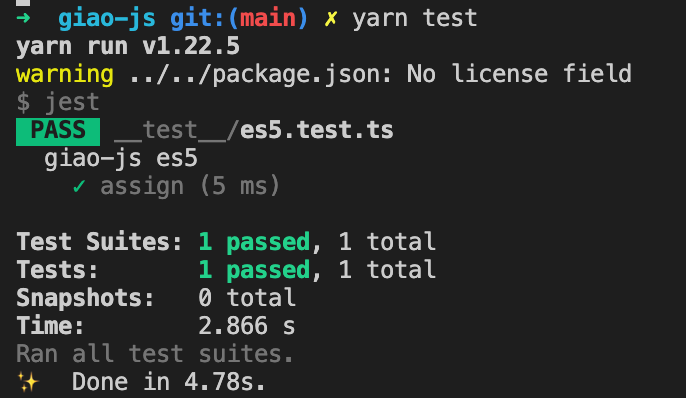
实践第 5 弹: for 循环
var result = 0;for (var i = 0; i < 5; i++) {
result += 2;
}
module.exports = result;
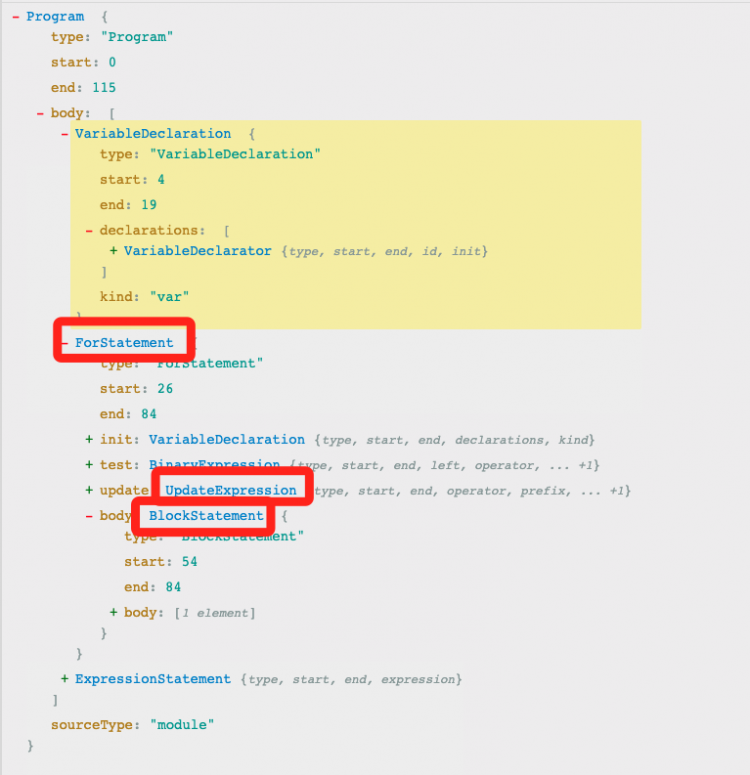
到这一弹大家都发现了,不同的语法其实对应的就是不同的树节点,我们只要实现对应的节点函数即可.我们先来看看这几个陌生节点的含义.
ForStatement
for 循环语句节点,属性 init/test/update 分别表示了 for 语句括号中的三个表达式,初始化值,循环判断条件,每次循环执行的变量更新语句(init 可以是变量声明或者表达式)。
这三个属性都可以为 null,即 for(;;){}。
body 属性用以表示要循环执行的语句。
interface ForStatement {type: "ForStatement";
init?: VariableDeclaration | Expression | null;
test?: Expression | null;
update?: Expression | null;
body: Statement;
}
UpdateExpression
update 运算表达式节点,即 ++/--,和一元运算符类似,只是 operator 指向的节点对象类型不同,这里是 update 运算符。
interface UpdateExpression {type: "UpdateExpression";
operator: UpdateOperator;
argument: Expression;
prefix: boolean;
}
BlockStatement
块语句节点,举个例子:if (...) { // 这里是块语句的内容 },块里边可以包含多个其他的语句,所以有一个 body 属性,是一个数组,表示了块里边的多个语句。
interface BlockStatement {0;
type: "BlockStatement";
body: Array<Statement>;
innerComments?: Array<Comment>;
}
废话少说,盘它!!!
// standard/es5.ts 实现以上节点方法import Scope from "../scope";
import * as ESTree from "estree";
type AstPath<T> = {
node: T;
scope: Scope;
};
const es5 = {
// ...
// for 循环语句节点
ForStatement(astPath: AstPath<ESTree.ForStatement>) {
const { node, scope } = astPath;
const { init, test, update, body } = node;
// 这里需要注意的是需要模拟创建一个块级作用域
// 前面Scope类实现,var声明在块作用域中会被提升,const/let不会
const forScope = new Scope("block", scope);
for (
// 初始化值
// VariableDeclaration
init ? this.visitNode(init, forScope) : null;
// 循环判断条件(BinaryExpression)
// 二元运算表达式,之前已实现,这里不再细说
test ? this.visitNode(test, forScope) : true;
// 变量更新语句(UpdateExpression)
update ? this.visitNode(update, forScope) : null
) {
// BlockStatement
this.visitNode(body, forScope);
}
},
// update 运算表达式节点
// update 运算表达式节点,即 ++/--,和一元运算符类似,只是 operator 指向的节点对象类型不同,这里是 update 运算符。
UpdateExpression(astPath: AstPath<ESTree.UpdateExpression>) {
const { node, scope } = astPath;
// update 运算符,值为 ++ 或 --,配合 update 表达式节点的 prefix 属性来表示前后。
const { prefix, argument, operator } = node;
let updateVar;
// 这里需要考虑参数类型还有一种情况是成员表达式节点
// 例: for (var query={count:0}; query.count < 8; query.count++)
// LHS查找
if (argument.type === "Identifier") {
// 标识符类型 直接查找
const value = scope.search(argument.name);
updateVar = value;
} else if (argument.type === "MemberExpression") {
// 成员表达式的实现在前面实现过,这里不再细说,一样的套路~
const { object, property, computed } = argument;
const obj = this.visitNode(object, scope);
const key = computed
? this.visitNode(property, scope)
: (<ESTree.Identifier>property).name;
updateVar = {
get value() {
return obj[key];
},
set value(v) {
obj[key] = v;
},
};
}
return {
"++": (v) => {
const result = v.value;
v.value = result + 1;
// preifx? ++i: i++;
return prefix ? v.value : result;
},
"--": (v) => {
const result = v.value;
v.value = result - 1;
// preifx? --i: i--;
return prefix ? v.value : result;
},
}[operator](updateVar);
},
// 块语句节点
// 块语句的实现很简单,模拟创建一个块作用域,然后遍历body属性进行访问即可。
BlockStatement(astPath: AstPath<ESTree.BlockStatement>) {
const { node, scope } = astPath;
const blockScope = new Scope("block", scope);
const { body } = node;
body.forEach((bodyNode) => {
this.visitNode(bodyNode, blockScope);
});
},
};
export default es5;
上 jest 大法验证一哈~
test("test for loop", () => {expect(
run(`
var result = 0;
for (var i = 0; i < 5; i++) {
result += 2;
}
module.exports = result;
`)
).toBe(10);
});
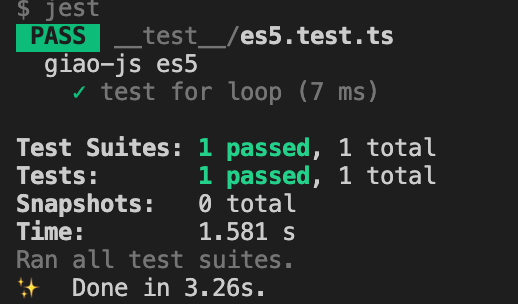
你以为这样就结束了吗? 有没有想到还有什么情况没处理? for 循环的中断语句呢?
var result = 0;for (var i = 0; i < 5; i++) {
result += 2;
break; // break,continue,return
}
module.exports = result;
感兴趣的小伙伴可以自己动手试试,或者戳源码地址
结语
giao-js目前只实现了几个语法,本文只是提供一个思路。
有兴趣的同学可以查看完整代码。
觉得有帮助到你的话,点个 star 支持下作者 ❤️ ~
参考
bramblex/jsjs
使用 Acorn 来解析 JavaScript
Build a JS Interpreter in JavaScript Using Acorn as a Parser
以上是 「 giao-js 」用js写一个js解释器 的全部内容, 来源链接: utcz.com/a/67511.html

